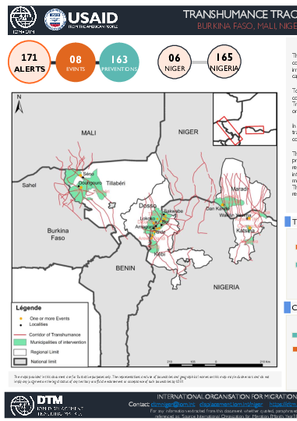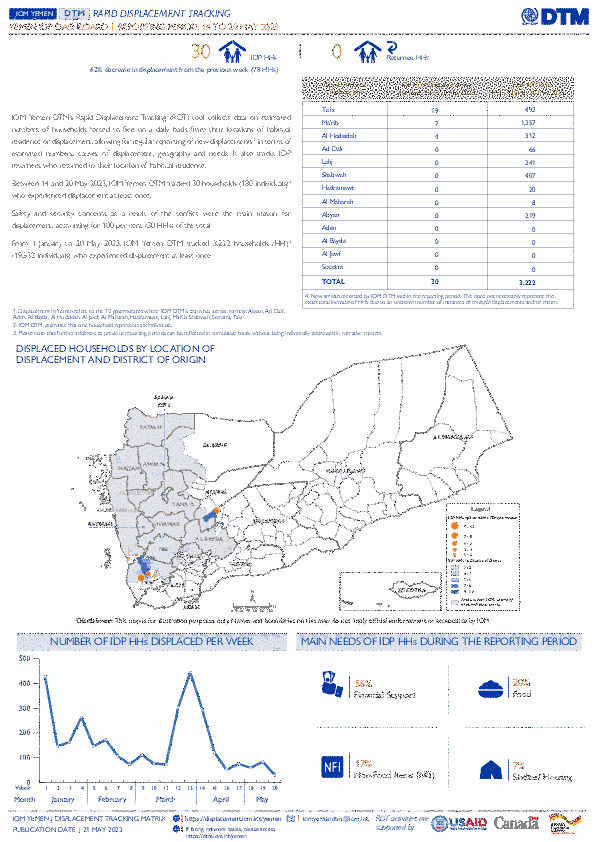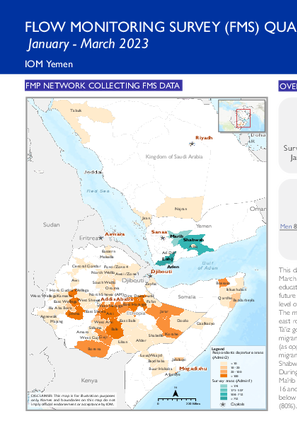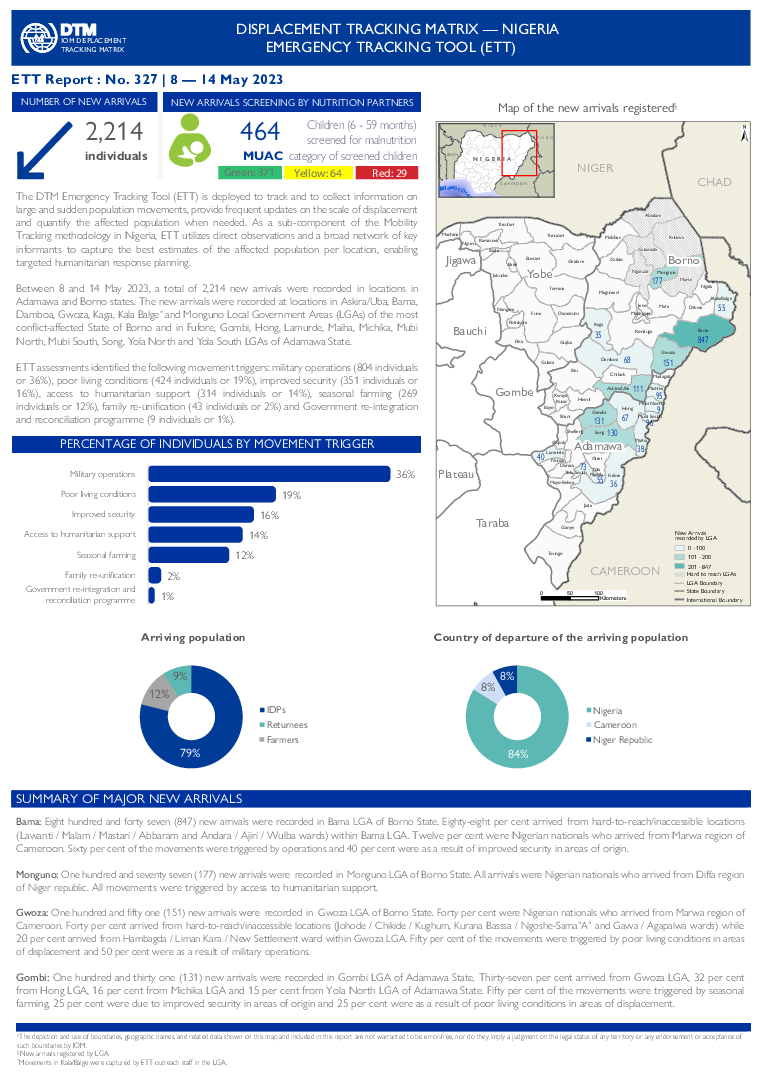-
Countries
-
Data and Analysis
-
Special Focus
-
Crisis Responses

Contact
DTM Niger, NigerDataResearch@iom.int, RODakar-DataResearch@iom.int
Language
English
Location
Niger
Period Covered
Jan 01 2023
Feb 28 2023
Activity
- Other
The transhumant livestock system is an ancient practice of migratory pastoralism between Sahelian countries towards coastal ones. These Sahelian countries are faced with vulnerability factors (security crisis, irregular rainfall, competition over natural resources) that threaten their sustainability, weaken their capacity to adapt and provoke tensions between communities that sometimes result in deadly conflicts.
To better understand transhumance movements trends and the impact of vulnerabilities on transhumant communities, IOM has developed the Transhumance Tracking Tool (TTT) through its Displacement Tracking Matrix DTM, with the Bilital Maroobe Network (RBM) and its “members, the pastoralist organisations”, to monitor transhumance in cross-border areas in countries where RBM operates.
In the framework of this project, the TTT provides an understanding of the dynamics of cross-border transhumance between Burkina Faso, Niger, Nigeria and Mali by combining three components: mapping, counting and alerting.
The purpose of the alert system is to identify events related to the use of natural resources, agro-pastoral practices, and disasters in the cross-border area of different countries, to understand existing conflict resolution methods, and to inform competent authorities to reduce tensions in the municipalities of intervention. This system makes it possible to identify alerts related to a conflict event (event alert) or to a massive, early, late or unexpected movement of livestock (prevention alert) that could lead to conflict. These alerts, once transmitted to the various actors, are used for conflict prevention or actions towards resolutions. This report presents data from the alert tool for the months of January to February 2022
Contact
DTM Yemen, iomyemendtm@iom.int
Location
Yemen
Activity
- Displacement Solutions
- Mobility Tracking
Period Covered
May 14 2023 -May 20 2023
From 1 January to 20 May 2023, IOM Yemen DTM tracked 3,222 households (HH) (19,332 Individuals) who experienced displacement at least once.
Between 14 and 20 May 2023, IOM Yemen DTM tracked 30 households (180 individuals) displaced at least once.
-
The majority of people moved into/within the following governorates and districts:
- Ta’iz (19 HHs) – Mawza (9 HHs), Maqbanah (6 HHs), Al Maafer (4 HHs) districts. Most displacements in the governorate were internal.
- Ma’rib (7 HHs) – Harib (7 HHs) district. All displacements in the governorate were internal.
- Al Hodeidah (4 HHs) – Al Khukhah (2 HHs), Hays (2 HHs) districts. Most displacements in the governorate originated from Ta’iz and Al Hodeidah.
- Ta’iz (19 HHs) – Maqbanah (8 HHs), Sharab Ar Rawnah (5 HHs), Mawza (3 HHs) districts.
- Ma’rib (7 HHs) – Harib (7 HHs) district.
- Al Hodeidah (2 HHs) – Hays (2 HHs) district.
Population Groups
Survey Methodology
Unit of Analysis Or Observation
Type of Survey or Assessment
Keywords
Geographical Scope
Administrative boundaries with available data
The current dataset covers the following administrative boundaries

Contact
DTM Yemen, DTMYemen@iom.int
Language
English
Location
Yemen
Period Covered
May 14 2023
May 20 2023
Activity
- Registration
- Mobility Tracking
IOM Yemen DTM’s Rapid Displacement Tracking (RDT) tool collects data on estimated numbers of households forced to flee on a daily basis from their locations of origin or displacement, allowing for regular reporting of new displacements in terms of estimated numbers, geography, and needs. It also tracks returnees who returned to their location of origin.
From 1 January to 20 May 2023, IOM Yemen DTM tracked 3,222 households (HH) (19,332 Individuals) who experienced displacement at least once.
Between 14 and 20 May 2023, IOM Yemen DTM tracked 30 households (180 individuals) displaced at least once. The majority of people moved into/within the following governorates and districts:
- Ta’iz (19 HHs) – Mawza (9 HHs), Maqbanah (6 HHs), Al Maafer (4 HHs) districts. Most displacements in the governorate were internal.
- Ma’rib (7 HHs) – Harib (7 HHs) district. All displacements in the governorate were internal.
- Al Hodeidah (4 HHs) – Al Khukhah (2 HHs), Hays (2 HHs) districts. Most displacements in the governorate originated from Ta’iz and Al Hodeidah.
The majority of people moved from the following governorates and districts:
- Ta’iz (19 HHs) – Maqbanah (8 HHs), Sharab Ar Rawnah (5 HHs), Mawza (3 HHs) districts.
- Ma’rib (7 HHs) – Harib (7 HHs) district.
- Al Hodeidah (2 HHs) – Hays (2 HHs) district.
IOM identified 6 households displaced in the previous reporting period, which covered 07 - 13 May 2023, in the governorates of Ma’rib (5 HHs), Ta’iz (1 HH). These figures have been added to the cumulative displacement total recorded since the beginning of the year.

Contact
DTM Mozambique, DTMMozambique@iom.int
Language
English
Location
Mozambique
Period Covered
Mar 01 2023
Apr 30 2023
Activity
- Mobility Tracking
This summary presents findings of the 18th round of Mobility Tracking Assessments (previously known as Baseline Assessments) conducted across Northern Mozambique through key-informant assessments and group interviews at district and location-level in March 2023. Mobility Tracking assessments estimate the presence of internally displaced persons (IDPs) and returnees across Northern Mozambique. IOM DTM mapped a total of 834,304 IDPs and 420,200 returnees in 221 locations.
Contact
DTM Mozambique, DTMMozambique@iom.int
Location
Mozambique
Activity
- Mobility Tracking
- Site Assessment
Period Covered
Mar 01 2023 -Apr 30 2023
A site assessment is a sub-component of mobility tracking. It aims to collect data on population presence, living conditions and needs in a particular displacement site or community.
Population Groups
Survey Methodology
Unit of Analysis Or Observation
Type of Survey or Assessment
Keywords
Geographical Scope
Administrative boundaries with available data
The current dataset covers the following administrative boundaries
Contact
DTM Mozambique, DTMMozambique@iom.int, vnyawara@iom.int
Location
Mozambique
Activity
- Mobility Tracking
- Site Assessment
Period Covered
Mar 01 2023 -Apr 30 2023
This summary presents findings of the 18th round of Mobility Tracking Assessments (previously known as Baseline Assessments) conducted across Northern Mozambique through key-informant assessments and group interviews at district and location-level in March 2023. Mobility Tracking assessments estimate the presence of internally displaced persons (IDPs) and returnees across Northern Mozambique. IOM DTM mapped a total of 834,304 IDPs and 420,200 returnees in 221 locations.
Population Groups
Survey Methodology
Unit of Analysis Or Observation
Type of Survey or Assessment
Keywords
Geographical Scope
Administrative boundaries with available data
The current dataset covers the following administrative boundaries
Contact
DTM Burundi, DTMBurundi@iom.int
Location
Burundi
Activity
- Mobility Tracking
- Event Tracking
Period Covered
May 14 2023 -May 20 2023
Activated on an ad hoc basis, the DTM Emergency Tracking provides early field reports at the beginning of a complex crisis, allowing IOM to gather, consolidate and disseminate baseline information on displacement and return figures at the onset of a newly emerging crisis. The DTM Emergency Tracking relies heavily on information provided by RARTs or partners within the humanitarian community about an unfolding situation. The Emergency Tracking gathers data through IOM Burundi’s extended network of key informants, who provide basic information on the new displacement, be it of IDPs or returnees, or both, including numbers, location and shelter types. While IOM DTM strives to provide best estimates, the Emergency Tracking aims to be a quick monitoring tool with real-time data turnover ranging from 24 to 72 hours following its activation.
Population Groups
Survey Methodology
Unit of Analysis Or Observation
Type of Survey or Assessment
Keywords
Geographical Scope
Administrative boundaries with available data
The current dataset covers the following administrative boundaries
Flow Monitoring is a component of DTM and it is used to track population movements inside a country, within a region or across regions. The dataset includes:
- monthly and daily figures on arrivals by sea and by land to Europe (Bulgaria, Cyprus, Greece, Italy, Malta, Spain)
- monthly and daily figures on transits along the Western Balkan region (Albania, Bosnia and Herzegovina, Croatia, Montenegro, North Macedonia, Romania, Slovenia, Serbia, Kosovo*)
- figures on reported country of origin of arrivals and transits
- figures on reported migrant presence in reception centers.
Population Groups
Survey Methodology
Unit of Analysis Or Observation
Type of Survey or Assessment
Keywords

Contact
DTM Yemen, DTMYemen@iom.int
Language
English
Location
Yemen
Period Covered
Jan 01 2023
Mar 31 2023
Activity
- Flow Monitoring Survey
This dashboard compiles flow monitoring survey (FMS) data collected in Yemen between January and March 2023 and provides an analysis of migrants’ demographic and socio-economic profiles, including education and employment backgrounds, reasons for leaving their country of origin or habitual residence, future travel intentions, protection and challenges faced during the journey. Also included migrants’ highest level of education achieved and their labour status prior to moving.
The migration routes in the southern part of Yemen are categorized along two main routes: the south-eastern route towards Hadramout and Shabwa governorates and the north-east route towards Lahj and Ta’iz governorates. Based on historical trends both routes are traditionally travelled by a large number of migrants each year. Through the Flow Monitoring Registry tool, which focuses on total numbers of migrants (as opposed to the more detailed migrant profile established through the FMS), DTM found that 41,453 migrants entered Yemen through the south in the first quarter of 2023 – mainly through Lahj (75%) and Shabwah (24%) with a significant increase in March.</p>
During the first quarter of 2023, a total of 2,435 surveys were conducted. In Lahj (1,042), Shabwah (712), Ma’rib (174) and Aden (507 migrants). The respondents were primarily young adults between the age of 16 and 25 (83%) searching for economic opportunities (91%), most of whom were single (92%), below average educational attainment (89%), were currently unemployed (94%) and departed from rural areas (80%).

Contact
DTM Nigeria, iomnigeriadtm@iom.int
Language
English
Location
Nigeria
Period Covered
May 08 2023
May 14 2023
Activity
- Mobility Tracking
- Event Tracking
The DTM Emergency Tracking Tool (ETT) is deployed to track and to collect information on large and sudden population movements, provide frequent updates on the scale of displacement and quantify the affected population when needed. As a sub-component of the Mobility Tracking methodology in Nigeria, ETT utilises direct observations and a broad network of key informants to capture the best estimates of the affected population per location, enabling targeted humanitarian response planning.
Between 8 and 14 May 2023, a total of 2,214 new arrivals were recorded in locations in Adamawa and Borno states. The new arrivals were recorded at locations in Askira/Uba, Bama, Damboa, Gwoza, Kaga, Kala Balge* and Monguno Local Government Areas (LGAs) of the most conflict-affected State of Borno and in Fufore, Gombi, Hong, Lamurde, Maiha, Michika, Mubi North, Mubi South, Song, Yola North and Yola South LGAs of Adamawa State.